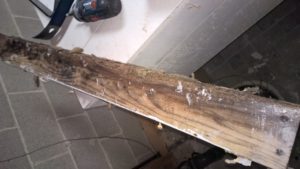Fungus/Mold on Basements Floor Joists
If you have mold on the floor joists in your basement, it is important that you get it remediated soon. Taking too long to do so can cause damage to your health or property. Here is some information about removing mold from floor joists and mold in general:
Is Mold Toxic/Dangerous?
The extent to which mold affects your health varies based off of many factors. The main ones being how sensitive you are to a particular type of mold and the amount of mycotoxins a particular type of mold releases into the atmosphere. Black mold on floor joists is generally more hazardous than white mold on floor joists, for example.
Health Issues Associated with Mold
- Memory issues
- Trouble thinking
- Brain fog
- Allergy issues
Where Can Mold Be Found?
Mold commonly grows where there are food and moisture sources. It also prefers wet climates, temperatures of around 70-80 degrees Fahrenheit, and poor air circulation. Here are some common food sources that mold can use to grow:
- Wood beams
- Basement ceiling joists
- Cinder blocks
- Drywall
- Concrete
By reading this information, you can see that mold can grow in quite a few places. Here are some common moisture sources that mold may use to grow:
- Heavy rains
- Busted plumbing and/or HVAC components
- Fire sprinklers
- Appliance problems
If you have been affected by any water damage issues like the ones described above, it is a good idea to repair them as soon as possible. Failing to do so could lead to more severe issues.
How to Know If There Is Mold in Your Property
Mold can be present even without being visible, so it’s important to know how to detect it. If you suspect that there is mold in your property, we recommend that you purchase a mold testing kit like the one found here. Catching the mold in its early stages of development can make the remediation processes cheaper and easier.
Is Mold Common?
Although mold is most common in wet and humid climates, it is still relatively common in many other places. As mentioned before, all mold needs to grow is a food and moisture source. Beyond that, some factors that contribute to a higher chance of mold growth include:
- Poor air circulation
- Mold spores in the air
- Temperatures of around 70 degrees Fahrenheit
- Non waterproofed building materials
Mold Removal from Wood Joists Process
Here is a simple breakdown of how a professional may remediate mold:
Step 1: Develop a Mold Redemption Plan
Your mold specialist should provide you with information, specific to your property, on how the process of removing mold from floor joists will work. You can then submit this along with other documentation, like a mold test done by an industrial hygienist, to your insurance company. Depending mainly on your insurance policy and how the damage occurred, it is possible that your insurance may at least partially cover the mold remediation work.
Step 2: Moving Your Personal Belongings in a Safe Place
If, for example, you have white mold on the floor joists in your crawl space, your personal belongings in the surrounding area may also become damaged by the mold. To prevent this, your restoration company should move your personal belongings to a separate part of your house during the remediation process.
Step 3: Solve the Moisture Issue
As mentioned before, moisture is one of the primary factors that mold requires to grow. That being said, if you have mold in your property, it is important that your mold remediation contractor find the moisture source and repair it. They will often use a moisture meter like the one found on our recommended products page in the detection process.
Step 4: Isolate the Affected Area
Isolation is a key factor in reducing the chances of mold spreading to other parts of the property during the remediation process. For a small mold issue, your contractor will likely only be required to shut all the doors and windows that are near the contaminated area. If there is a larger amount of mold present, your contractor will need to additionally block off any contaminated areas with polyethylene sheeting.
Step 5: Demolish the Mold Damaged Areas
Simply cleaning the mold off of the surface may not remove all of it. For this reason, your mold mitigation service provider will need to demolish and dispose of the mold damaged areas.

Step 6: Properly Throw Away the Removed Building Materials
Professionals should use caution when disposing of mold damaged areas, because if done incorrectly, mold can grow back. For this reason, mold pros often double-bag the materials in specialized polyethylene bags before disposal. It is a good idea to additionally wipe down the outside of the bags to sanitize them.
Step 7: Clean and Sanitize
After the demolition process is complete, mold professionals can begin to clean and sanitize the mold damaged area. This is often done with wire brushes and disposable wipes.
Step 8: Water Damage Repair
Even though the leak source was fixed in the previous steps of this process, there may still be some moisture present. To dry this remaining moisture, your restoration professional can use specialized fans and dehumidifiers. They may also use something to raise the temperature in the room to help the drying process.
Step 9: Reconstruction
The goal of this process is to get the building back to its original state, or possibly into even better condition. Not all restoration contractors will offer this service, but they may be able to at least sub contract or recommend another company to help you with this.
Step 10: Repairing Your Personal Belongings
In order to get the building back to how it was before, the company you hire will need to clean, repair, and put back your personal belongings. Although your insurance company may not always want to pay for your damaged and totaled items, it may be worth documenting the process and submitting a claim.
Prevent Mold from Returning
Here are some things to look out for in order to prevent mold from returning:
- Maintaining your plumbing and HVAC components
- Checking for moisture issues on a regular basis
- Waterproofing
- Cleaning and maintaining your roof and gutters
- Using an air purifier to lessen the amount of mold spores in the atmosphere
- Ventilating your property
Call Now!
If your home or commercial property has been damaged by mold on the basement floor joists, call today for a free estimate!
